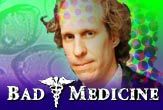Restraint and Equipment Use for Beef Cattle
My Big Beef with Cloned Cattle

The meat and milk from cloned animals are safe to eat and should be allowed for sale, according to the U.S. Nutrient and Drug Administration.
And you'll never know, anyhow, considering the labeling will be a clone of the labeling used for not-cloned beef. No special labeling is needed, the FDA says in an article published in the Jan. ane result of Theriogenology and in the full 678-page study posted on the FDA spider web site final week.
The less we know the better, apparently. Why else would the results of a 4-year investigation in cloning prophylactic be announced quietly betwixt Christmas and New Year's?
Cloning dates back hundreds of days
On ane level, we've allowed cloned beef to penetrate America for years. It's called McDonald'south. While non technically cloned, all billion or and then of the hamburger patties sold are indistinguishable from each other. This is our future.
| Bad Medicine |
| Bad Medicine appears each Tuesday on LiveScience. Previous columns: |
On another level, you lot might have already eaten existent cloned beef. Cloning livestock has been going on for five years now, and the FDA merely initiated a voluntary moratorium in 2003 on the commercial sale of the offspring of cloned animals. In this era of censorship and compromised priorities at the CDC, EPA and NASA, the FDA didn't have the teeth to make the auction of cloned brute products illegal.
Cloning advocates are already painting us concerned consumers as Luddites, with minds too feeble to comprehend that cloning is only an extension of animal husbandry practices that take taken place for centuries. This is a natural progression, they say, like feeding herbivorous cattle the ground-up remains of other animals, which somehow brought about mad moo-cow disease.
Every bit safety as cloned female parent's milk
Are cloned animal products safe? Probably, but that'southward not the whole issue. Cloned cattle would be a chip off the old chipped beef, genetically identical to the progenitors. Scientists accept the Deoxyribonucleic acid of a prized bull or dairy cow and insert this into a hollowed-out almost microscopic cattle egg. An electrical shock, eerily familiar to Frankenstein, induces the egg to grow.
Consequence one is long-term human being safety. While the practice is likely rubber, only a few years have passed since the dawn of cloning to truly understand the impact this would have on millions of livestock consumed by hundreds of millions of people.
Result ii is the long-term viability of the nutrient supply. Nature likes multifariousness; this is why virtually animals reproduce sexually. A disease can more easily wipe out an entire herd if each animal is genetically identical.
Outcome three is the appalling secrecy. Consumers have the right to know whether their nutrient product was raised in a matter that is acceptable to them. Of course the biggest producers don't want the FDA to crave special labeling. The majority of consumers are queasy with the idea of cloning animals, as revealed in a recent poll past the Pew Initiative on Nutrient and Biotechnology.
Issue iv is the necessity. Why practice we need to clone livestock? Information technology's because big business concern, the face of American farming practices, demands identical products for mass production. And these identical slabs of meat line the meat sections of identical supermarkets from Albuquerque to Yonkers.
Uncertain hereafter
Butchers have almost entirely disappeared from America. Gone is the 24-hour interval of specialty cuts and regional flavors. Instead, iv meatpacking companies slaughter and package about 85 percent of all beef in the United States, according to the USDA. Supermarkets merely rent a few meat-cutters to trim the nearly finished production.
The biggest meat producers will likely crave their suppliers to provide a genetically perfected product, which only the largest suppliers could afford to do. Once again, the little guy is marginalized. Already I am unable to purchase many of the meat products I grew upwards with in my Italian neighborhood, like sweetbreads. Small farmers are barred by police force from slaughtering their ain animals; and the overtaxed slaughterhouses volition merely render sure cuts.
Such is the diversity of the American food supply system. Cloning volition bring more of the aforementioned. We have until April 2 to mutter to the FDA virtually this. Then the FDA volition make its last conclusion.
Christopher Wanjek is the writer of the books "Bad Medicine" and "Food At Work." Got a question about Bad Medicine? Email Wanjek. If it'southward actually bad, he just might reply it in a hereafter cavalcade. Bad Medicine appears each Tuesday on LIveScience.
- Cow-free Beef Proposed
- 21st Century BBQ: Jucier Beefiness from Cloned Cows
- Food Science: Building Better Steaks, Wings and 'Chops
- Pork Makeover: New Push for Dark Meat
Source: https://www.livescience.com/9484-big-beef-cloned-cattle.html
Postar um comentário for "Restraint and Equipment Use for Beef Cattle"